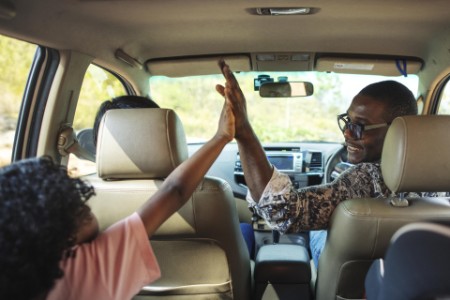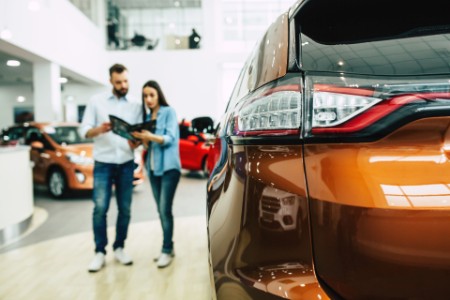
Chapter 1
Four key areas of change
Dealers can adapt in these areas to position themselves to take advantage of future opportunities.
Four key areas of change are evident: information gathering, finance and admin, touch and feel, and price transparency and unbundling.
Information gathering
The dealership is traditionally the hub for customers in terms of gathering information about both the vehicle they will buy and how they will buy it. Dealers’ business models are built around the one-to-one rapport that is forged between customer and salesperson, relationships which form the basis for selling not only vehicles but also upselling a range of related products – service packages, insurance and finance, for example.
However, our research shows that customers are increasingly using multiple channels for information gathering, especially when it comes to buying EVs. Existing car owners looking to buy their first EV seek reassurance that they are making the right choice. EVs are unfamiliar territory for those more used to internal combustion engine (ICE) vehicles, and 49% make use of both online and offline channels to gather information and gain confidence in their decision-making.
Dealers are still part of the process, for now at least. But to remain front-of-mind will require a better understanding of the customer decision journey, and a transition away from the traditional focus on getting a sale and toward a more advisory and supporting role. Dealers should aim to be the customers’ copilot, a trusted expert providing the information, advice and guidance they need to reassure them that they are making the right choice.
That means building a better picture of where individual customers are on their decision journey, and how they can best be helped to complete it. Dealers will need to develop new ways of making the first online contact as well as physical contact with prospective buyers, building trusted relationships with customers, and managing the transition between online and offline channels smoothly.
Finance and admin
Selling vehicle finance at the point of sale is a major profit driver for dealers, and the process of finalizing documents and paperwork is further used to upsell a variety of add-on products around maintenance, insurance and so forth.
But while in-person admin looks to the dealer like a significant value-add opportunity, to customers used to slick e-commerce style purchasing, it is a hassle they are increasingly keen to avoid. Both non-car owners and owners display a marked preference for arranging finance online rather than in person. Two-thirds (66%) of potential car buyers prefer to get quotations and secure financing online, while 29% agree or strongly agree that completing paperwork online is preferable to doing so at the dealership.
Quotations and financing
66%of potential car buyers prefer to get quotations and secure financing online.
This clearly has substantial revenue implications for dealers. But those who fail to adapt to this change in attitudes risk losing customers who seek the same quick, smooth and hassle-free online completion experience they receive from other service providers. On the upside, successful transition to a more digital sales model will also present new opportunities to sell on optional extras such as higher vehicle specs, new finance and insurance products and even integrated mobility packages rather than vehicles alone. Our experience suggests that customers who use flexible digital tools to tailor and complete a purchase are more likely to up their spend, as the value of a better spec or the peace of mind associated with additional insurance often only crystallizes in their minds after the hurdle of securing a favorable initial deal has been crossed.
Touch and feel
Over 50% of both owners and non-car owners prefer to experience a car physically before purchase, while 57% of non-car owners and 61% of owners looking to buy an EV want a test drive, either at home or at a convenient location. On the face of it, this looks like a win for the dealership status quo with its emphasis on the physical product experience. But is it? There is more than one way to experience a car, and new players in the market are winning share with innovative approaches. Brand advocates or even friends and family can seem more “authentic” and trustworthy than salespeople on commission, while test-drives can be provided at customers’ homes or workplaces, obviating the need for dedicated — and expensive — premises.
Both these findings point to a shift in the emphasis for dealerships and retail presence generally. Customers do want to physically experience a car, but they want to do it on their own terms rather than the dealer’s. Is the dealer network of the future a mix of “at home” trials, experiential high touch points in more convenient high street locations, and larger out of town “edutainment” centers for a more in-depth driving experience and immersive brand knowledge?
Price transparency and unbundling
For dealers who already face the prospect of losing out on traditional upselling opportunities during the finance and admin process, price transparency and unbundling pose another real threat to profitability. Our research points to a growing desire for price transparency among car owners and non-owners alike, cited by 36% and 39%, respectively. These groups prefer to know upfront how much they can spend on an EV, while over 50% in both categories prefer a fixed final price for a deal with no haggling. A haggle-free buying experience was listed as the number one motivator for buying direct from the OEM rather than via a dealership.
This search for price transparency is also driving a related trend toward unbundling. The purchase of a new car has historically often been accompanied by the trade-in sale of an old one, something which has not only provided dealers with additional revenue and considerable flexibility on deal structure, but also a ready supply of stock for their used car sales operations. But, aided and abetted by the rise of heavily marketed online third-party used car buying services, customers are increasingly opting to unbundle the transaction and sell their old cars elsewhere rather than trading them in at the dealership.
The lesson from the wider retail sector is that greater price transparency leads to more competition on price and ultimately lower profitability.

Chapter 2
Four key customer groups
Car buyers can be grouped by their attitudes toward, and preferences for, certain factors.
All car buyers are not the same, however. Segment analysis reveals that beneath these macro trends lies substantial variation in customer attitudes. Four key groups of car buyers are identified in the research – Digital progressives, Mainstream persuadables, Die-hard convenience seekers and Sensible progressives – based on their attitudes to sustainability, the buying experience, EVs vs. ICEs and preference for dealerships vs. online channels.
Spotlight on sustainability
Digital progressives display high levels of environmental awareness and are also the most likely to choose an EV as their next vehicle. They are also digitally forward, with a substantial majority wishing to use digital showrooms and to complete paperwork online – a combination that may account for the apparent success of some EV OEMs who have adopted a pure-play digital sales model, despite the strong preference for dealers demonstrated by other segments in this analysis. But as one of the smaller segments, accounting for 15% of the customers surveyed, the potential market share of such a digital-only approach may be limited – at least for the time being.
Multi-channel on the rise
Sensible progressives are utility buyers who weigh up all the options before making what looks to them like the most sensible choice. On average, they are likely to choose an EV as their next vehicle; being pragmatists, however, they are among the least willing to pay a premium for one. They use both online and offline channels for research but are the group most likely to rely entirely on digital channels for their final purchase. Sensible progressives account for 20% of customers surveyed.
EV attitudes – all to play for
Mainstream persuadables are car users (via rental or car sharing and taxi services) who are less likely to be car owners already, but who are looking to buy. They are slightly more likely than average to buy an EV, but they do have the second-highest willingness to pay a premium for one. They are open-minded consumers who, as the name suggests, are ready to be convinced that an EV is the car for them. At 50% of those surveyed, they are also the largest cohort by far – twice the size of the next biggest group identified.
Dealership devotees
Die-hard convenience seekers are the oldest group and also the most likely to use a dealership to experience a car, as well as to make their final purchase. The majority are car owners and prefer the convenience of traveling that way above all – they are lower than average users of other modes of transport. But despite being the most “traditional” group, over a third would prefer an EV as their next vehicle. At 15% of those surveyed, they are one of the two smallest segments.

Chapter 3
Implications for dealers and OEMs
With substantial hits to key sources of profit they currently rely on, dealers and OEMs must adapt.
The picture painted by these findings is of customers in flux and a market in transition. A small number of early adopters who are keen to make the move to online may distract a more fundamentally heterogenous truth – the majority of buyers are neither die-hards nor innovators but lie somewhere on the spectrum in between.
What is clear, however, is that dealers and OEMs alike face substantial hits to several of the key sources of profit that they currently rely on. Shifts to online in information gathering, finance and price transparency may look modest individually, but collectively they are not. The trend for unbundling trade-ins from new car purchasing in particular has the potential to knock away one leg of the dealership’s traditional three-legged stool business model – a firmly planted tripod based on sales, aftersales and used cars may become a distinctly wobbly two-legged affair of sales and aftersales only.
So, should dealers and OEMs continue to pursue their own parallel furrows, or join forces and share the customer relationship – and the revenues it generates – in new multichannel ways? And what does the business model of the future look like? Is it an open platform that is accessible to all? Or is it a network model based on specific third-party partnerships?
Answering these questions requires more than tinkering round the edges, or a timid watching brief – it calls for a fundamental rethinking of the dealers’ role and the relationship between dealers, OEMs and customers. By reinventing themselves as trusted expert advisors and copilots on the decision journey, dealers stand the best chance not only of maintaining existing revenues as much as possible, but also of positioning themselves to take advantage of new opportunities as they arise.
Segment analysis such as outlined here can help make sense of the complexity of a market in transition and provide OEMs and dealers with insights that can illuminate the road ahead. The customers’ ultimate destination may not yet be decided, but it is undeniable that they are on the move toward an online multichannel future. The consequences for dealers and OEMs that fail to adapt may not be immediately fatal, but they will face an increasingly unhappy prognosis.
Summary
The findings from the latest Mobility Consumer Index show most car buyers aren’t ready to move the entire car-buying process online, but they are on the road toward an online multichannel future. To adapt, dealers should become trusted advisors and copilots on the decision journey.

